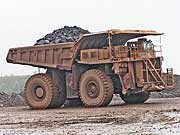Friday, January 9, 2026
A timeline of Minnesota's Iron Range
May, 2006
Minnesota's Iron Range was formed some two billion years ago, and its rich iron ore deposits have been mined since the mid-1800s. Here are some notable events in the history of the area.
May, 2006
Minnesota's Iron Range was formed some two billion years ago, and its rich iron ore deposits have been mined since the mid-1800s. Here are some notable events in the history of the area.
| 1865 |
George Stuntz discovers iron ore near Lake Vermilion while investigating a report of gold deposits in the area. |
| 1868 |
The Minnesota Legislature commissions Stuntz to build the Vermilion Trail.
|
| 1884 |
First ore ships from the Vermilion Range.
|
| 1892 |
First ore ships from the Mesabi Range.
|
| 1911 |
First ore ships from the Cuyuna Range.
|
| 1907 | The Western Federation of Miners organizes a labor strike on the Mesabi Range. The first widespread labor strike on the Range is relatively peaceful and short-lived, but yields no significant gains for the miners. |
| 1908 |
After a summer of extensive drought, Chisholm is devastated by forest fire.
|
| 1916 |
The second major labor strike in the region, this time organized by the Wobblies (Industrial Workers of the World) is marked by violence and intimidation.
|
| 1924 |
The worst mining disaster in Minnesota takes place on the Cuyuna Range, as 41 miners drown in the Milford mine when nearby Lake Foley breaks through the underground mine.
|
| 1930-1935 |
More than one-half of iron ore extracted from the earth originates in Minnesota mines.
|
| 1941 |
The first tax on taconite, a black magnetic iron-bearing ore, goes into effect in Minnesota.
|
| 1951 |
More than 82 percent of iron ore extracted from United States' mines originates in Minnesota.
|
| 1959 |
The opening of the St. Lawrence Seaway makes the Iron Range accessible to the Atlantic Ocean.
|
| 1967 |
Last iron ore shipment leaves the Vermilion iron range.
|
| 1980 |
Last iron ore shipment leaves the Cuyuna iron range.
|
| 1982 |
Taconite mining emerges as the future employment source for the Iron Range, providing jobs for 12,000 workers. The subsequent recession and trend toward mechanization reduces that number by half within 15 years. |
| 1984 |
Last iron ore shipment leaves the Mesabi iron range, ending Minnesota's direct iron ore industry and confirming a difficult depression on the Iron Range.
|
![]()




